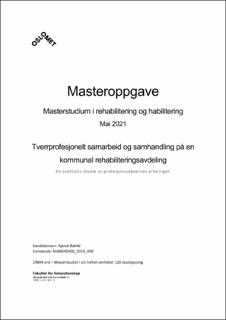| dc.contributor.advisor | Dahl-Michelsen, Tone | |
| dc.contributor.author | Baklid, Kjersti Kathinka | |
| dc.date.accessioned | 2024-03-22T09:08:14Z | |
| dc.date.available | 2024-03-22T09:08:14Z | |
| dc.date.issued | 2021-05 | |
| dc.identifier.uri | https://hdl.handle.net/11250/3123735 | |
| dc.description.abstract | Bakgrunn: Rehabilitering for pasienter som har omfattende behov, krever tett, tverrprofesjonelt samarbeid der flere tjenester og profesjoner (som regel) er involvert. De komplekse samarbeidsformene som kreves, og særlig det å holde tråden i rehabiliteringsprosessene, har vist seg å være utfordrende å få til i praksis.
Hensikt og metode: I denne studien utforsker jeg hva som kjennetegner tverrprofesjonelt samarbeid og samhandling på en rehabiliteringsavdeling. Hensikt med studien er å synliggjøre ett eksempel på hvordan tverrprofesjonelt samarbeid og samhandling kan se ut i en konkret praksis som i stor grad fungerer etter de politiske intensjonene. Edwards teori om tverrprofesjonelt samarbeid i komplekse bruker-/ pasientsaker utgjør studiens teoretiske rammeverk. Prosjektet har en kvalitativ tilnærming og designet er en single case studie. Det empiriske materialet er samlet inn gjennom ett fokusgruppeintervju med representanter fra de profesjonene som vanligvis er tilknyttet arbeidet på en kommunal døgnrehabiliteringsavdeling. Analysen er tematisk.
Funn: Funnene viser hvordan det tverrprofesjonelle samarbeidet og samhandlingen på en kommunal rehabiliteringsavdeling særlig kjennetegnes ved at profesjonsutøverne tilstreber å etablere en relasjon basert på felles forståelse og praksis i møte med rehabiliteringspasienten og deres pårørende. Det overordnede temaet som er analysert frem, er «Bli kjent» prosesser. De ulike «Bli kjent» prosessene handler om å skape innsikt, felles forståelse, trygghet, tillit og engasjement i hverandre og de ulike rehabiliteringsprosessene – med pasient og pårørende, og innad mellom de som jobber på rehabiliteringsavdelingen. «Bli kjent» prosessene handler om å bli kjent med og utvikle de ressursene som er tilgjengelig, og erkjenne ulikheter en må ta høyde for. «Bli kjent» prosessene kjennetegnes av å være dynamiske og i endring underveis i rehabiliteringsforløpet.
Konklusjon: De komplekse «bli kjent» prosessene som kjennetegner det tverrprofesjonelle samarbeidet og samhandlingen på den kommunale rehabiliteringsavdelingsavdelingen i denne studien, illustrerer hva som kjennetegner et tverrprofesjonelt samarbeid og samhandling, der de representerte profesjonsutøverne opplever å ha en velfungerende felles forståelse og tilnærming til rehabiliteringsprosessen. Funnene fra studien kan bidra som eksempel til bevisstgjøring og inspirasjon for å se kompleksiteten i, og utvikle det tverrprofesjonelle samarbeidet og samhandlingen på kommunale rehabiliteringsavdelinger. | en_US |
| dc.description.abstract | Background: Rehabilitation of patients who are in extensive needs, demands a close inter-professionally collaboration where (usually) several services and professions are involved. The complexity that this way of working together requires, especially to hold on to the common thread, has been experienced a challenge to implement in real life.
Purpose and method: In this study I explore what signifies inter-professionally collaboration and interaction on a municipal (day-and-night) rehabilitation unit. The purpose with the study, is to make a tangible example of how inter-professionally collaboration and interaction can look like in a concrete, practical setting that largely functions according to the political intensions. Edwards theories of inter-professional collaboration responses to complex client/ patient problems makes the theoretical framework in this study. The project has a qualitative approach with a single case study design. The empirical material is gathered through a focus group interview with representatives from the professions that usually are included in a municipal rehabilitation unit. The analysis is thematic.
Findings: The findings shows how the inter-professional collaboration and interaction on a municipal rehabilitation unit is especially characterised by how the practitioners aspire to establish a relation based upon common understanding and practice when working with the rehabilitation patients and their next to kin. The main theme of this analysis is «To get to know» processes. What the different «To get to know» processes are about, is to create insight, common understanding, safety, trust and engagement in each other and in the different rehabilitation processes – with patient and next to kin, and between all those who are working on the rehabilitation unit. «To get to know» processes are about to get to know, and to develop the resources that are available, and to acknowledge the differences that needs to be taken into account. «To get to know» processes are characterised by being dynamic and a product of transformation during the course of rehabilitation.
Conclusion: The complex «To get to know» processes that characterises the inter-professional collaboration and interaction on the municipal rehabilitation unit in this study, illustrates what characterises an inter-professional collaboration and interaction where the represented practitioners experience to have a well-functioning common understanding and approach to the rehabilitation process. The findings of the study can be used as an example to contribute to consciousness-raising and inspiration to be aware of the complexity in, and to develop the inter-professional collaboration and interaction on municipal rehabilitation units. | en_US |
| dc.language.iso | nob | en_US |
| dc.title | Tverrprofesjonelt samarbeid og samhandling på en kommunal rehabiliteringsavdeling : En kvalitativ studie av profesjonsutøvernes erfaringer | en_US |
| dc.type | Master thesis | en_US |
| dc.description.version | publishedVersion | en_US |
